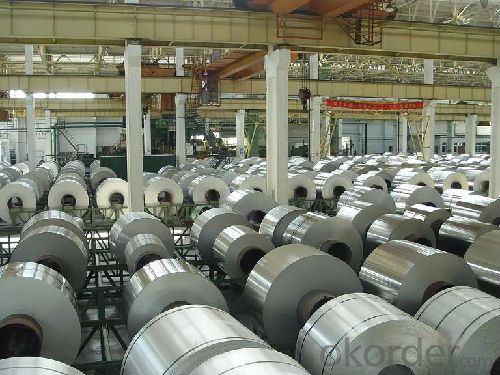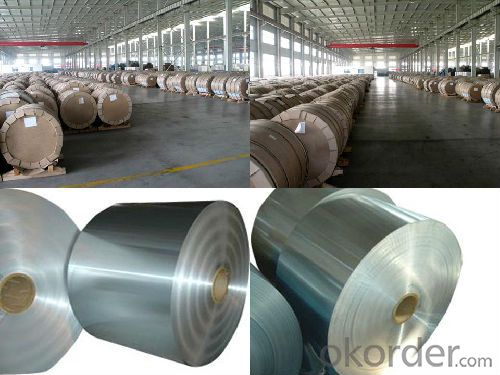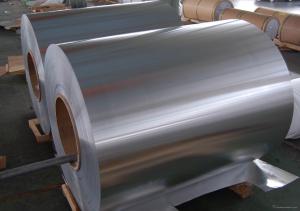Aluminum Coil of 500-2000kgs Avaliable for Customer
- Loading Port:
- Shanghai
- Payment Terms:
- TT or LC
- Min Order Qty:
- 5 m.t.
- Supply Capability:
- 15000 m.t./month
OKorder Service Pledge
OKorder Financial Service
You Might Also Like
1.Structure of Aluminum Coil of 500-2000kgs Avaliable for Customer :
Mill Finished Aluminum Coil is designed for many field such as electronics, instruments, lighting decoration, packing industry, and house decoration, curtain wall, honeycomb-core panel, sandwich panel, aluminum composite panel, aluminum composite pipe etc.. Mill finished aluminum coil for is hard and everlasting under the blazing sun. You can choose the alloys as your habitation and we will do our best to meet your requests.
2.Main Features of the Aluminum Coil of 500-2000kgs Avaliable for Customer:
• Smooth surface
• High manufacturing accuracy
• High strength of extension and yield
• Well packaged
• No marks, no scratch, no excessive oil
3. Aluminum Coil of 500-2000kgs Avaliable for Customer
Alloy: | AA1050, 1060, 1070, 1100, 3003, 3004, 3005, 3105, 5052, 5083, 5754, 8011, 8006 |
Temper: | H14, H16, H18, H22, H24, H26, H32, O/F |
Thickness: | 0.2-100mm |
Width: | 30mm-1700mm |
4. Production of Aluminum Coil of 500-2000kgs Avaliable for Customer


5.FAQ
We have organized several common questions for our clients,may help you sincerely:
① How about your company?
A world class manufacturer & supplier of aluminum coil and alloy blanks. Aluminum production base is comprised of 18 aluminum annealers, 10 coil and foil mills, 4 continuous production lines, 2 hot rolling production line and 3 prepainted lines.
Export 5000 tons per month to Asia, America and Middle East. Always do the best for our clients.
②Can you guarantee the quality of the products?
We are responsible for the quality of materials to get a long-term cooperation with clients in a reasonable period of time and we are glad to arrange and coordinate any third party inspection for you.
③What is the delivery time after purchase?
35 day after receiving client’s deposit or correct LC
- Q:And what are the advantages/disadvantages of steel aluminum in building cars?Which would be better for building cars?
- Steel and aluminum are both pretty strong, but aluminum is lighter. This gives a better strength/weight ratio. Aluminum is not as easy to weld as steel so this is a disadvantage but it is easier to sheet-form and do simple machining on. Aluminum would be better than steel for cars as it is strong enough while being much lighter - ending up in a faster, but equally dangerous hot rod.
- Q:Are aluminum coils suitable for solar panel frames?
- Indeed, solar panel frames can be made from aluminum coils. Aluminum, being both lightweight and resistant to corrosion, is an optimal choice for constructing solar panel frames. Moreover, its exceptional durability enables it to endure diverse weather conditions, ultimately ensuring the prolonged lifespan of the solar panel structure. Furthermore, aluminum possesses excellent heat dissipation properties and is effortless to manipulate, which is vital for solar panels as they generate heat whilst operating. By utilizing aluminum coils in solar panel frames, the efficiency and performance of the entire solar panel system can be significantly improved.
- Q:How do aluminum coils contribute to energy efficiency in buildings?
- Aluminum coils play a crucial role in enhancing energy efficiency in buildings. Firstly, aluminum is a highly conductive material, allowing for efficient heat transfer. This characteristic is essential in HVAC (Heating, Ventilation, and Air Conditioning) systems, where aluminum coils are commonly used. These coils facilitate the transfer of heat between the indoor and outdoor units, enabling effective temperature regulation and reducing energy consumption. Moreover, aluminum coils are lightweight, which makes them easier to handle and install. This not only saves time and labor costs but also reduces the overall weight of the HVAC system, leading to lower energy requirements for operation. Additionally, the lightweight nature of aluminum coils allows for the design of compact systems, saving valuable space in buildings. Furthermore, aluminum is highly resistant to corrosion, ensuring the longevity and durability of the coils. This resistance to corrosion is particularly crucial in areas with high humidity or exposure to harsh weather conditions. By maintaining their effectiveness over time, aluminum coils minimize the need for frequent replacements, reducing energy consumption associated with manufacturing and installation processes. Another significant benefit of aluminum coils is their recyclability. Aluminum is one of the most recycled materials globally, with a high recycling rate and minimal loss of quality during the process. By using aluminum coils, buildings contribute to a more sustainable and environmentally friendly approach, as the material can be recycled repeatedly without compromising its performance. Moreover, the recycling process requires significantly less energy compared to primary aluminum production, reducing greenhouse gas emissions. In conclusion, aluminum coils contribute to energy efficiency in buildings through their high conductivity, lightweight nature, corrosion resistance, and recyclability. By facilitating efficient heat transfer, reducing energy consumption, and promoting sustainability, aluminum coils play a vital role in enhancing the energy efficiency of HVAC systems and overall building performance.
- Q:How are aluminum coils used in heat exchangers?
- Aluminum coils are widely used in heat exchangers due to their excellent thermal conductivity and corrosion resistance. They are typically used as the main component in the evaporator and condenser sections of the heat exchanger. The coils facilitate the transfer of heat between two fluids, allowing for efficient cooling or heating processes. The design of the coils, along with their large surface area, helps to maximize heat transfer and enhance the overall performance of the heat exchanger.
- Q:How are aluminum coils joined or welded?
- Aluminum coils can undergo various methods of joining or welding, depending on the specific application and desired outcome. Some commonly employed techniques are: 1. Mechanical fastening: This involves physically fastening the aluminum coils together using bolts, screws, or rivets. Mechanical fastening is a cost-effective and straightforward method suitable for thin coils or temporary connections. 2. Adhesive bonding: Specialized adhesives are used to bond aluminum coils together in adhesive bonding. This method creates a strong and durable joint, evenly distributing stress across the entire bond area. Adhesive bonding is often used when aesthetics, weight reduction, or vibration dampening are important considerations. 3. Resistance welding: Resistance welding employs an electric current to generate heat and pressure at the joint, effectively welding the aluminum coils. This method is particularly suitable for high-speed production lines, providing a strong and reliable joint. However, it requires specialized equipment and may not be suitable for all aluminum alloys. 4. Laser welding: Laser welding is a precise and efficient method that utilizes a laser beam to melt and join the aluminum coils. This technique allows for precise control of heat input, resulting in minimal distortion and excellent weld quality. Laser welding is commonly used in industries where high precision and aesthetic appearance are crucial, such as automotive and aerospace. 5. Friction stir welding: Friction stir welding is a solid-state joining process that employs a rotating tool to generate heat and friction, effectively welding the aluminum coils without melting the material. This method produces strong and high-quality welds with minimal distortion and no need for additional filler material. Friction stir welding is commonly used in industries that require excellent mechanical properties and high productivity, such as shipbuilding and railway construction. Overall, the choice of joining or welding method for aluminum coils depends on factors such as desired joint strength, application requirements, production volume, and available equipment and expertise.
- Q:Are aluminum coils suitable for electrical conductors?
- Yes, aluminum coils are suitable for electrical conductors. Aluminum is a good conductor of electricity, second only to copper in terms of conductivity. It is widely used in various electrical applications, including power transmission lines, wiring, and electrical coils. Aluminum coils offer excellent electrical conductivity while also being lightweight, cost-effective, and resistant to corrosion.
- Q:Can aluminum coils be used in the manufacturing of beverage cans?
- Yes, aluminum coils can be used in the manufacturing of beverage cans. Aluminum coils are commonly used in the production of beverage cans due to their lightweight, corrosion-resistant, and malleable properties. These coils are processed and shaped into cans during the manufacturing process, providing a durable and cost-effective solution for packaging beverages.
- Q:What are the cost implications of using aluminum coils?
- The cost implications of using aluminum coils can vary depending on several factors. Generally, aluminum coils tend to be more expensive initially compared to other materials like copper. However, they offer long-term cost savings due to their durability, corrosion resistance, and energy efficiency. Aluminum coils also require less maintenance and have a longer lifespan, reducing replacement and repair costs. Additionally, aluminum coils are lighter, which can result in lower transportation and installation expenses. Therefore, while the upfront cost may be higher, the overall cost savings and benefits of using aluminum coils make them a cost-effective choice in the long run.
- Q:What do you think of the stainless steel with copper and aluminum core cookware? And what's a good brand?
- Plastic! High temperature plastic! The inside is coated with Teflon a high temp polymer and the outside is aluminum foil. Take the cookware, tip it upside down and spray it with Rustoleum copper tone and presto, you have the cooper bottom like Revere Wear. When you are done after being careful to cook only low temp foods, throw it away thus eliminating the chores of doing dishes and practicing going green with no water used. Oh, by the way, the name of this cookware is Flash-in-The Pan!
1. Manufacturer Overview |
|
|---|---|
| Location | |
| Year Established | |
| Annual Output Value | |
| Main Markets | |
| Company Certifications | |
2. Manufacturer Certificates |
|
|---|---|
| a) Certification Name | |
| Range | |
| Reference | |
| Validity Period | |
3. Manufacturer Capability |
|
|---|---|
| a)Trade Capacity | |
| Nearest Port | |
| Export Percentage | |
| No.of Employees in Trade Department | |
| Language Spoken: | |
| b)Factory Information | |
| Factory Size: | |
| No. of Production Lines | |
| Contract Manufacturing | |
| Product Price Range | |
Send your message to us
Aluminum Coil of 500-2000kgs Avaliable for Customer
- Loading Port:
- Shanghai
- Payment Terms:
- TT or LC
- Min Order Qty:
- 5 m.t.
- Supply Capability:
- 15000 m.t./month
OKorder Service Pledge
OKorder Financial Service
Similar products
New products
Hot products
Related keywords




























